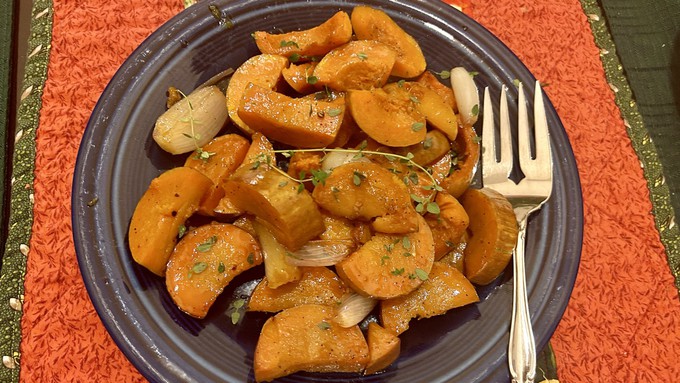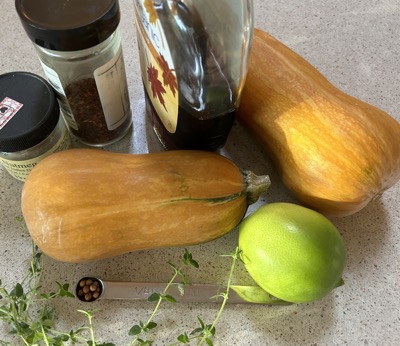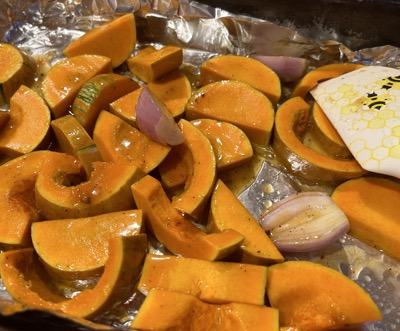
Recipe: Maple glaze is subtly spiced; lime juice adds balance

Sprinkled with lime juice and fresh thyme just before serving, the Honey Nut squash makes a delicious seasonal side dish. Kathy Morrison
It's squash season -- decorative and otherwise -- which means we vegetable gardeners get to explore all the things that squash can do. Well, beyond pie, which is a given.
This is the first year I've successfully grown Honey Nut squash. This little squash, which looks like butternut's younger, oranger sibling, is a relatively new member of the squash family. It was developed by a Cornell University Institute plant breeder, Michael Mazourek, who in 2009 was challenged by a New York chef to create a squash that was smaller, sweeter and less stringy than the ubiquitous butternut. I'd say he succeeded.

As a bonus, Honey Nut is much easier to cut in half than just about any other orange squash, and the skin is thin enough to eat when cooked, so no peeling needed.
Back in May I planted two hills of seeds at the base of a strong trellis, and they've been very happy, sprawling but taking up much less room than, say, a pumpkin plant. The largest one I've harvested so far is about 1-1/2 pounds, the smallest just half a pound. Like other squash, they need to cure for about 10 days before cooking or storing.
"You grew it, now eat it!" says Farmer Fred Hoffman. OK, let's show off this cute squash in a side dish that doesn't overwhelm with sweetness. This version was freely adapted from a NY Times recipe. The spices can be adjusted for personal taste, but if at all possible don't leave out the lime juice -- it balances the spicy-sweet perfectly. (And my limes are ripening, too -- nice timing.)
Looking ahead: Doubled, this recipe would make a fine addition to a Thanksgiving spread.
Roasted winter squash with spiced maple glaze
Serves 3-4
Ingredients:

1 to 1-1/2 pounds small winter squash(es), such as Honey Nut, Sweet Dumpling or Delicata
2 shallots, peeled and cut in half or quartered, depending on size
3 tablespoons real maple syrup
Large pinch Aleppo pepper or crushed red pepper flakes, or to taste
2 tablespoons unsalted butter
1/8 teaspoon coriander seeds or ground coriander
1/2 teaspoon kosher salt
1/4 teaspoon ground black pepper
Pinch of ground nutmeg
Pinch of smoked paprika
For serving:
Several sprigs of fresh thyme
Lime juice from 1/2 fresh lime
Instructions:
Line a roasting pan with heavy-duty foil (preferred), or sturdy parchment paper, and grease the inside lightly with oil spray or heat-tolerant cooking oil (grapeseed oil is my go-to for this). Preheat oven to 425 degrees F.
Cut the stem and blossom ends off the squash, and slice the squash in half. Scoop out the seeds. (A melon baller is useful for this.) Slice each half crosswise into 1/2-inch slices. Place the slices in a large bowl, along with the shallot pieces, and set aside.

In a small saucepan, simmer the maple syrup and Aleppo pepper on medium-high heat for 1 to 3 minutes. Don't walk away from the stove -- this can overcook or scorch easily. You just want to concentrate and flavor the syrup a bit.
Remove the pan from the heat and stir in the butter, which will melt, and the coriander, salt and pepper, nutmeg and smoked paprika.
Pour the mixture over the squash slices and shallot pieces, and stir to coat evenly.
Place the squash mixture, including all the liquid, in the prepared pan in one layer.
Roast for 15 minutes. Stir the vegetables, flipping them over, and cook for an additional 10 minutes or until skin on the squash is tender.
Remove from heat and place the vegetables on a serving platter or bowl. Squeeze the lime half over the vegetables, then strip the thyme off the stems and sprinkle it over the plate, and serve.
Comments
0 comments have been posted.Sacramento Digs Gardening to your inbox.
Sites We Like
Garden Checklist for week of May 12
Get your gardening chores and irrigation done early in the day before temperatures rise.
* Plant, plant, plant! It’s prime planting season in the Sacramento area. Time to set out those tomato transplants along with peppers and eggplants. Pinch off any flowers on new transplants to make them concentrate on establishing roots instead of setting premature fruit.
* Direct-seed melons, cucumbers, summer squash, corn, radishes, pumpkins and annual herbs such as basil.
* Harvest cabbage, lettuce, peas and green onions. This heat will cause leafy greens and onions to flower; pick them before they bolt.
* In the flower garden, direct-seed sunflowers, cosmos, salvia, zinnias, marigolds, celosia and asters.
* Plant dahlia tubers. Other perennials to set out include verbena, coreopsis, coneflower and astilbe.
* Transplant petunias, marigolds and perennial flowers such as astilbe, columbine, coneflowers, coreopsis, dahlias, rudbeckia and verbena.
* Keep an eye out for slugs, snails, earwigs and aphids that want to dine on tender new growth.
* Feed summer bloomers with a balanced fertilizer.
* For continued bloom, cut off spent flowers on roses as well as other flowering plants.
* Got fruit trees? If you haven't already done so, thin orchard fruit such as apples, peaches, pears, pluots and plums before they grow too heavy, breaking branches or even splitting the tree. Leave the largest fruit on the branch, culling the smaller ones, and allow for 5 to 6 inches (or a hand's worth) between each fruit.
* Thin grape bunches, again leaving about 6 inches between them. For the remaining bunches, prune off the "tail" end, about the bottom third of the bunch, so that the plant's energy is concentrated in the fruit closest to the branch.
* As spring-flowering shrubs finish blooming, give them a little pruning to shape them, removing old and dead wood. Lightly trim azaleas, fuchsias and marguerites for bushier plants.
* Add mulch to the garden to help keep that precious water from evaporating. Mulch also cuts down on weeds. But don’t let it mound around the stems or trunks of trees or shrubs. Leave about a 6-inch to 1-foot circle to avoid crown rot or other problems.